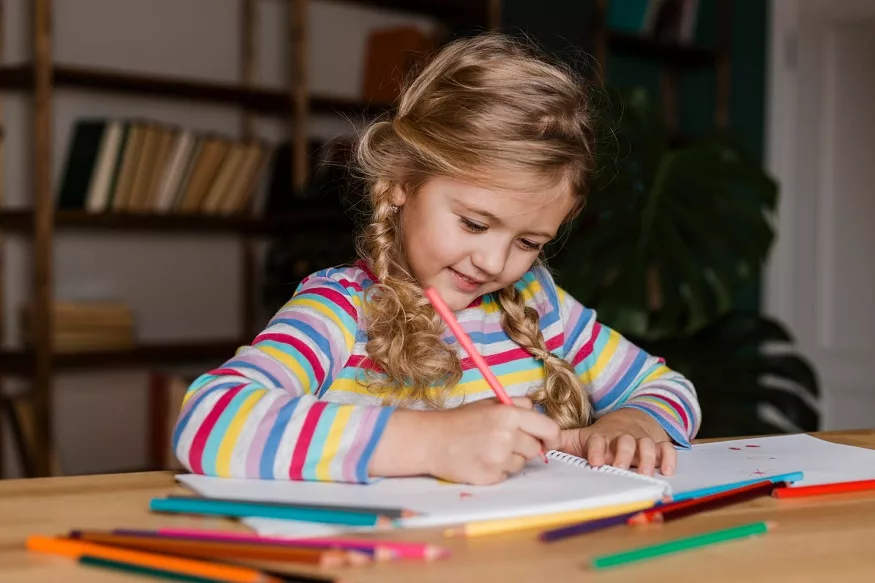Drawing is important for kids as it develops their creativity and fine motor skills. Though it starts with scribbles on walls and papers, their drawings get precise and beautiful as they grow older. Drawing is fun because it gives them a chance to create something that doesn’t exist like Pizza cats or flying horses. Another beautiful thing about drawing is that even mistakes can be turned into something great.
Effective Ways to Boost Your Child’s Drawing Skills:
Encourage your child to draw on a regular basis. Spend time for sketching activities along with your kids and supply a variety of drawing materials such as pencils, crayons, markers, and sketchbooks, this will help child development. The more they practise, the more their drawing ability will grow.
Take your kids to art museums, introduce them to diverse art styles and techniques through books or websites, and involve them in discussions about various artists and their works. Training kids to draw on a variety of subjects can also foster creativity and help in drawing development.
Always give your child critical and positive feedback on his or her drawings. Praise their efforts, highlighting specific areas you like, and making mild suggestions for improvement. This will enhance their confidence and passion to keep practising and experimenting with their artwork.
Motivate your kid to sketch using their imagination. Ask children to make up stories or narratives to go along with their drawings. This will not only help in the drawing development but also improve their storytelling abilities while also making the stages of drawing more engaging and pleasurable.
Encourage your child to experiment with new drawing approaches and styles. Allow children to try with other mediums, such as water colours, pastels, or charcoal. This will enable students to identify their preferences and create a diverse skill set.
Support your kid in making contacts with other young artists or art communities. Look for art classes, workshops, or online venues where kids may share their work and receive comments from peers or mentors in their area. This connection will help in child development as it gives them a sense of belonging while also providing crucial information about how to develop their talents.
Also read : 7 Sequencing Activities for Kindergarten & Preschoolers
Benefits of drawing:
Drawing is extremely important for child development since it offers several benefits that help in their overall development and progress.
Enhancing Creativity:
Drawing development helps children build their imaginations and teaches them to think outside the box. Drawing allows youngsters to visualise and express their unique thoughts, encouraging them to create their own universe. This creative approach sparks their artistic abilities and inspires them to think creatively.
Developing Fine Motor Skills:
This is the most important one among the benefits of drawing for kids. Holding and handling a pencil or crayon to make different shapes and lines helps children improve fine motor skills. Drawing needs fine hand-eye coordination and control, which promotes flexibility and agility in their hands and fingers.
Improving Concentration:
Drawing improves children’s focus and concentration. Children learn to pay attention to details, observe forms and colours, and pursue their creative ideas from beginning to end while immersed in their artwork. This prolonged attention practice can also be transferred to other tasks, improving their ability to concentrate in numerous areas of life.
Enhancing Cognitive Abilities:
Drawing development gives a boost to children’s cognitive ability in addition to making visually appealing images. As students explore various techniques, viewpoints, and compositions, drawing promotes intellectual curiosity, spatial reasoning, and visual analysis, all of which aid in cognitive growth.
Emotional Expression:
Through various stages of drawing, children can graphically express their thoughts and sentiments. When words are few, sketching allows youngsters to express their thoughts, feelings, and emotions in a nonverbal and symbolic manner. It can be a cathartic and therapeutic outlet for youngsters, assisting them in processing and understanding their own emotions.
Boosting Self-Confidence:
When kids create art, they are proud of their efforts. Each drawing is unique evidence of their ideas and abilities. Children’s self-confidence improves as they receive positive comments and encouragement from adults and peers, inspiring them to explore deeper and experiment with various artistic styles. This confidence can spread beyond art and have a positive impact on other aspects of their lives.
Also read : Top 20 Best Animated Movies for Kids
Stages of drawing:
The stages of drawing for kids can vary, however, they can generally be divided into four categories,
Scribbling Stage:
During the early years, usually between the ages of one and three, children start with random scribbling. They are currently experimenting with crayons or pencils and enjoying the sensory experience of making marks on paper. They may not understand the significance of the lines and shapes they draw, but they are gaining control over their hand movements.
Basic Forms Stage:
In these stages of drawing, around the age of three to four, children begin to sketch basic shapes. They begin to recognise and draw simple forms like circles, squares, triangles, and lines. These shapes are not precisely formed, yet they serve as the foundation for more complicated drawings. Children may also begin to incorporate facial elements into their drawings, such as eyes, noses, and mouths.
Pictorial Stage:
Children enter the pictorial stages of drawing between the ages of four and seven. They become more conscious of their environment and begin to draw recognisable objects. They create portraits of family members, pets, or anything they come across in their daily life. This stage is characterised by more complexity and more purposeful attempts to generate easily identifiable pictures.
Realistic Stage:
Children start the realistic stages of drawing around the age of seven. They polish their skills and strive for more accurate depictions. To make more lifelike drawings, they pay attention to dimensions, perspective, and shading. Children will discover their own style and preferences in terms of topic matter and artistic approaches at this stage.
Also read : Classy Tin Can Craft Ideas for Kids
Conclusion:
It is important to realise that these stages of drawing are not fixed or consecutive. In EuroSchool we understand that children develop at their own speed, and their artistic abilities can differ. With state-of-the-art infrastructure, amenities, and the best-in-class teaching staff, we encourage, support, and expose kids to various art materials and techniques that can help them develop their creativity and expand their artistic ability. Visit EuroSchool to know more.











